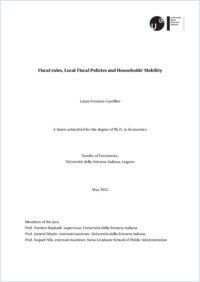Fiscal rules, local fiscal policies and households’ mobility
- Fontana-Casellini, Laura
- Parchet, Raphaël (Degree supervisor)
- 2022
PhD: Università della Svizzera italiana
Switzerland
Cantons
Municipalities
Public finances
Cantonal finances
Municipal finances
Local finances
Financial outcomes
Fiscal rules
Vertical interaction
Stringency
Deficit
Debt
Migration
Mobility
Households
Taxation
Tax rate
Schooling expenditures
Subsidies
Public Goods
Distributed-lag model
Distributed lag model
Reform dynamics
Svizzera
Cantoni
Comuni
Finanze pubbliche
Finanze cantonali
Finanze locali
Finanze comunali
Regole di bilancio
Interazione verticale
Severità
Debito pubblico
Migrazione
Mobilità
Nuclei famigliari
Nucleo famigliare
Nucleo familiare
Tassazione
Tasso d’imposta
Spese per l’educazione
Sussidi
Beni pubblici
Dinamica di una riforma
Schweiz
Kantone
Gemeinden
Öffentliche Finanzen
Kantonsfinanzen
Gemeindefinanzen
Schuldenbremse
Vertikale Interaktion
Haushalte
Mobilität
Steuern
Steuersatz
Öffentliches Gut
Dynamik einer Reform
English
This thesis includes three papers of applied research in the field of public finance and households' mobility in the Swiss setting. Chapter 1 is dedicated to the analysis of fiscal rules on fiscal performance, making use of the timely staggered introduction of different balanced budget requirements at the Swiss cantonal level over the past 50 years. Results from a distributed-lag model show that more stringent fiscal rules at the cantonal level improve cantonal surplus through increased revenues, while expenditures are unaffected. Debt stabilizes to a lower level. We rule out that cantonal fiscal rules had a direct impact on the finances of their municipalities, but rather indirectly through transfers reduction. Chapter 2 focuses on the introduction of fiscal rules at the Swiss municipal level and their effect on local financial outcomes. The analysis is performed with a distributed-lag model exploiting their staggered and exogenous introduction over the past 4 decades. First, estimation suggests that more stringent fiscal rules decrease per capita expenditures by 8% and per capita revenues by 8.3% in the long-term, de facto restricting government's size. Second, failing to control for the dynamic effects leads to a substantial effect underestimation for both expenditures and revenues. Third, the effect is heterogeneous and largest in jurisdictions with above-average population. Chapter 3 investigates mobility reactions to tax rates and public goods in Switzerland. We match administrative data covering the whole population to income data from the social security earnings, and we analyze 1,500,000 households' relocations over eight years (2010-2017). We first show that migration profiles are similar across income groups and decrease in age. Migration responses to the net-of-tax rate and to local spending are analyzed by income groups using an aggregate model of migration flows between municipality pairs. Our results show heterogeneous responses: the tax-base elasticity to net-of-tax rate seems positive and predominantly driven by households without children in the highest quartile of the income distribution. The estimated elasticity is around 3 for the top 10% incomes and stable across specifications. We proxy public good's provision by school expenditures and childcare subsidies. We find a negative relationship between school expenditures and mobility inflows. In contrast, subsidies have a positive impact.
- Collections
- Language
-
- English
- Classification
- Economics
- License
-
License undefined
- Open access status
- green
- Identifiers
-
- NDP-USI 2022ECO003
- URN urn:nbn:ch:rero-006-120465
- ARK ark:/12658/srd1322376
- Persistent URL
- https://n2t.net/ark:/12658/srd1322376
Statistics
Document views: 319
File downloads:
- 2022ECO003: 275
